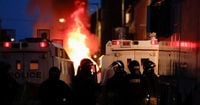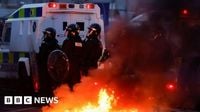On November 28, 2025, Northern Ireland’s legal system took a dramatic turn in a case that had gripped and divided communities for nearly half a year: prosecutors formally withdrew attempted rape charges against two Romanian teenagers, aged just 14 and 15, whose arrest had ignited a wave of racially-motivated riots across Ballymena and beyond. The decision, delivered at Belfast Youth Court, marks the end of a fraught chapter that saw not only legal scrutiny but also deep social unrest, with the reverberations of those June nights still echoing across the region.
The story began on June 7, 2025, when the two boys were accused of attempting to rape a schoolgirl in Ballymena, County Antrim. According to court reports cited by BBC News, there were initial claims that the girl had been dragged down an alleyway into a garage, but managed to escape when her alleged attackers were disturbed and fled. The gravity of the accusations, combined with the ages of those involved, meant the case was always going to be sensitive. Yet few could have predicted just how far-reaching its impact would be.
Within days of the arrests, what started as a peaceful protest in Ballymena on June 9 quickly spiraled out of control. Masked individuals broke away from the main crowd, building barricades, attacking properties along Clonavon Terrace, and hurling petrol bombs, bricks, and fireworks at police. As Reuters reported, the violence rapidly escalated, with cars set ablaze, windows smashed, and the disorder spreading to Newtownabbey, Carrickfergus, and north Belfast. The unrest was not confined to a single night; it persisted for nearly a week, drawing in communities from Larne—where a leisure centre providing emergency shelter for families was set on fire—to Portadown, Coleraine, and even Derry and Newry.
Underlying the violence was a toxic mix of fear, anger, and suspicion, much of it directed at immigrant communities. Migrants’ homes were targeted, and the riots took on an unmistakably anti-immigrant character, as noted by Reuters. The events prompted Police Scotland to send officers to Northern Ireland, underscoring the scale of the emergency. By June 14, while the worst of the disturbances had subsided, sporadic incidents—including attempted criminal damage to vehicles—were still being reported. The scars left by those nights would not heal quickly.
Meanwhile, the legal proceedings against the two teenagers moved slowly. Both boys were held in a juvenile detention centre for over five months, unable to be identified due to their ages. A third youth, also suspected of involvement, reportedly fled to Romania the day after the alleged attack, a detail confirmed by multiple sources including BBC News and Reuters. Throughout, the teenagers maintained their innocence, and their solicitor told the court early on that they would be denying the charges.
On November 28, the Public Prosecution Service (PPS) made its pivotal announcement. A spokesperson explained, “We have recently been made aware of significant evidential developments in this case. In light of this new evidence, it has been determined that the test for prosecution is no longer met on evidential grounds, and therefore the case should not proceed.” The PPS and police met with the complainant and her family that morning to explain the reasons for the decision, a step intended to provide transparency and support amid what was undoubtedly a difficult moment for all involved.
The defense barristers raised no objection to the withdrawal, with counsel noting, “The sooner this can be relayed to Woodlands [Juvenile Justice Centre] the sooner these two youths can be released.” District Judge George Conner, presiding over the case, acknowledged the profound sensitivity of the matter, remarking, “The less I say about it the better.” His restraint was echoed by many officials, mindful of the intense public scrutiny and the risk of further inflaming tensions.
Detective Chief Inspector Stephanie Finlay, speaking on behalf of the Police Service of Northern Ireland, struck a careful balance between reassuring the public and urging restraint. “Any reported sexual crime is taken extremely seriously and thoroughly investigated,” she stated, adding, “We continue to encourage those who have been victims of sexual crimes to come forward and report to us. You will be dealt with sensitively and will be offered the appropriate additional support.” She also issued a plea for calm, saying, “I would remind everyone to remain respectful in light of today’s decision, and refrain from speculation, particularly on social media.” According to Reuters, she further emphasized, “The Police Service of Northern Ireland will follow up on all lines of enquiry as we seek to ensure justice.”
For the families of those involved—both accused and accuser—the past five months have been a crucible of anxiety and public exposure. The decision to withdraw charges, while a relief for the Romanian teenagers and their supporters, does not erase the trauma experienced by the complainant or the wider community. Nor does it undo the damage wrought by the riots, which left homes burned, public trust shaken, and Northern Ireland’s delicate social fabric further strained.
The timeline of the unrest offers a sobering portrait of how quickly a local incident can escalate into widespread disorder. On June 9, a peaceful protest gave way to violence in Ballymena. By the next night, attacks on police and arson had spread. June 11 saw the worst disorder, with attacks on a leisure centre in Larne and ongoing unrest in multiple towns. Water cannon were deployed by June 13 in Portadown, and by June 14, sporadic disturbances continued, albeit at a lower level. Amid the chaos, smaller but significant gestures—such as a peaceful anti-racism protest in west Belfast—offered glimpses of a community striving for unity in the face of division.
None of the accused can be identified publicly due to their ages, a legal safeguard that has sometimes frustrated public curiosity but is intended to protect the rights of minors. The PPS’s decision to withdraw the charges was made purely on evidential grounds, as repeatedly emphasized by spokespeople and officials. “Significant evidential developments” was the phrase used, but the precise nature of the new evidence has not been disclosed, likely due to the ongoing sensitivity and privacy concerns surrounding the case.
While the immediate legal proceedings have now concluded, the aftermath of the case and the riots it sparked will linger in Northern Ireland’s collective memory. The episode has prompted renewed debate about race, justice, and the responsibilities of both authorities and communities in maintaining order and fairness. As Detective Chief Inspector Finlay noted, the police will continue to pursue all lines of enquiry—an assurance that, for many, will be crucial in restoring faith in the system.
The release of the two teenagers from custody brings closure to one chapter, but the broader issues exposed by this case—of community tension, the dangers of rumor and speculation, and the vital importance of due process—remain as urgent as ever.

